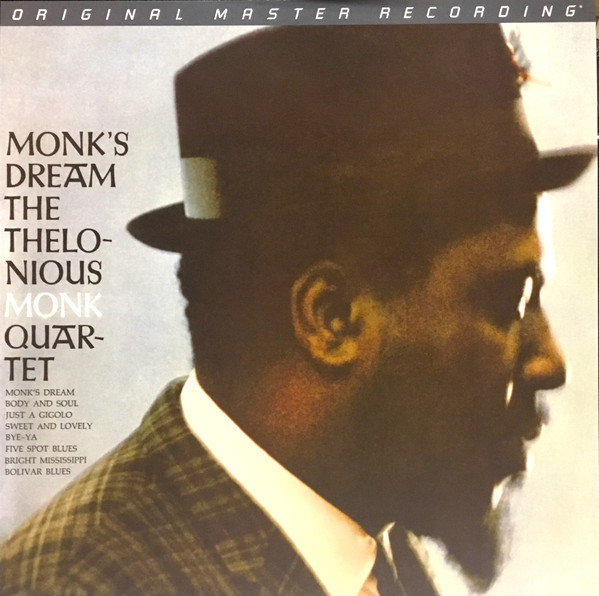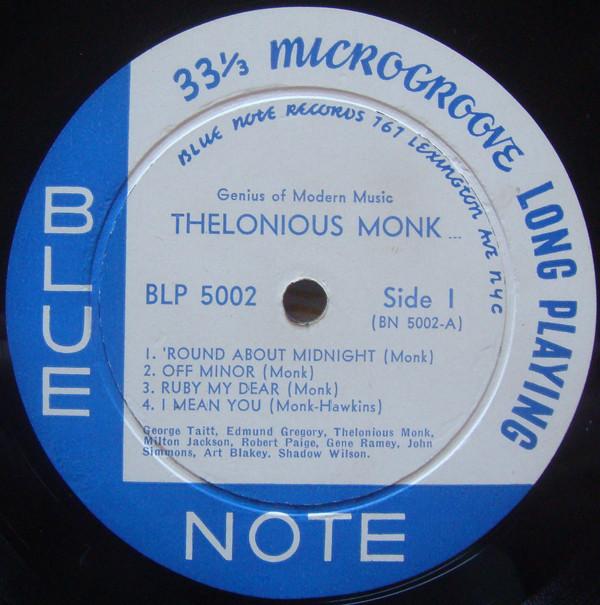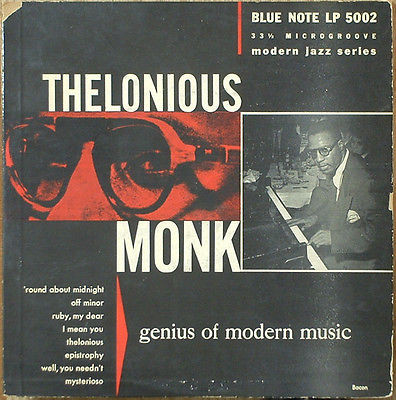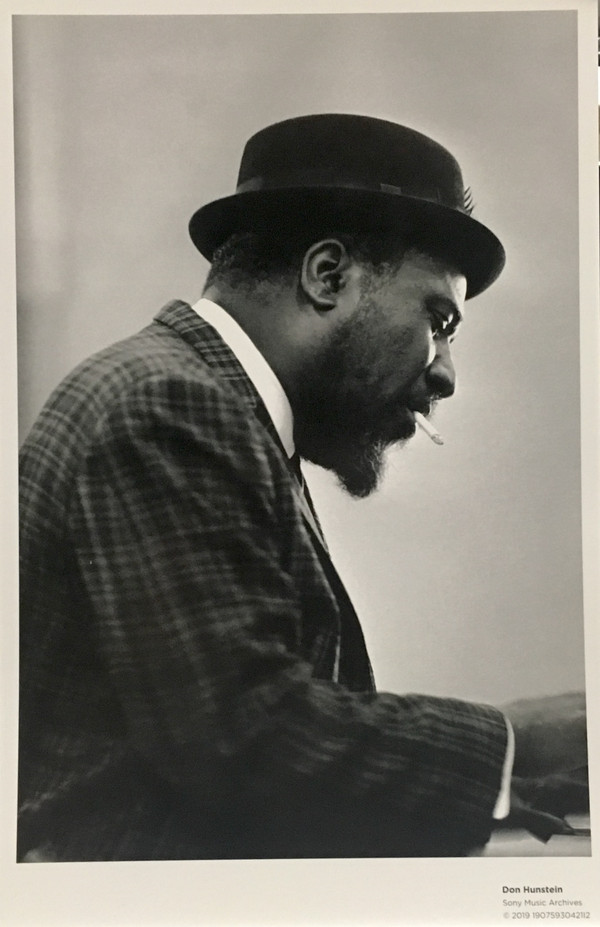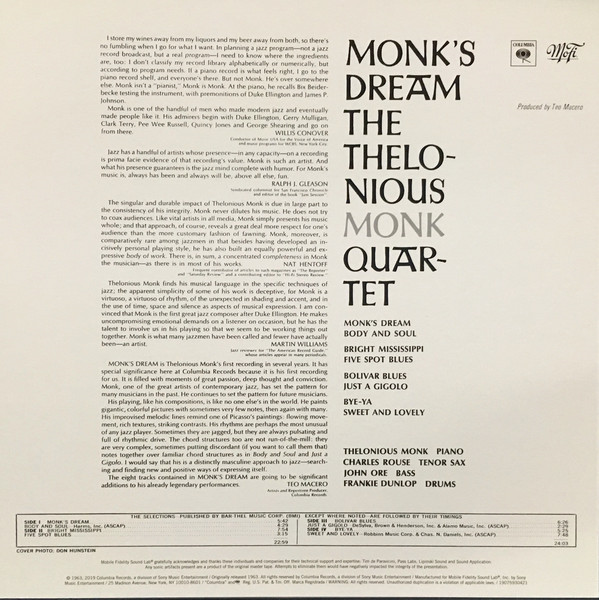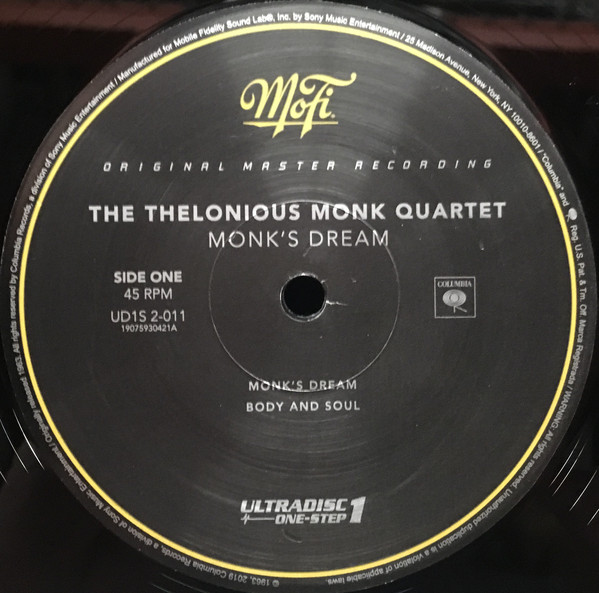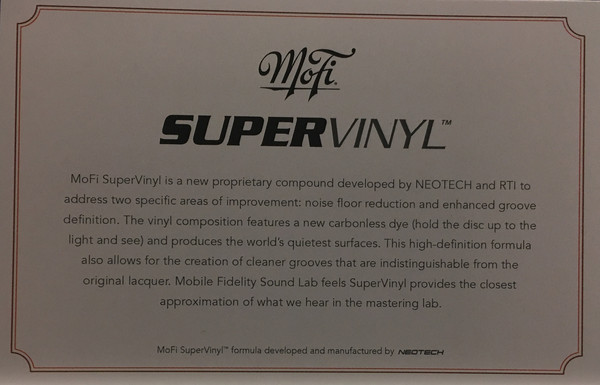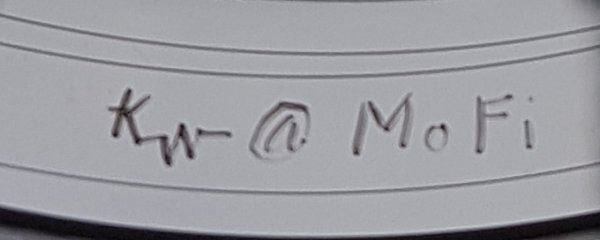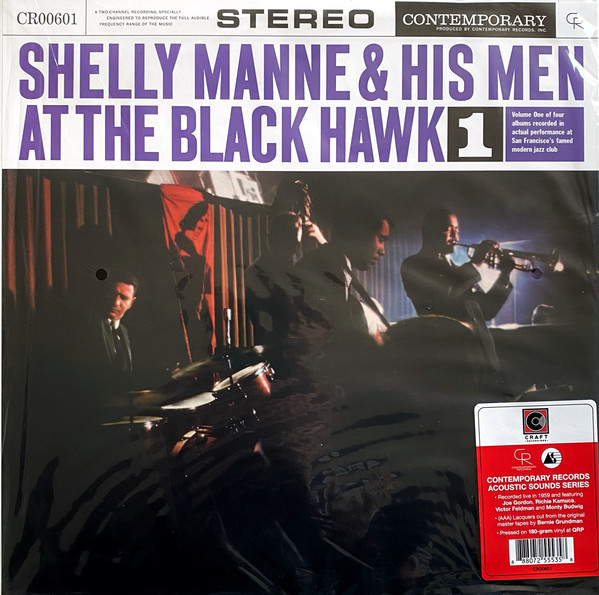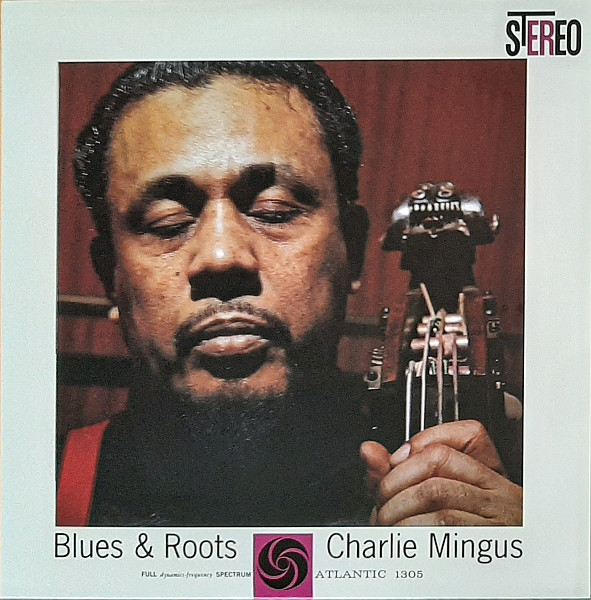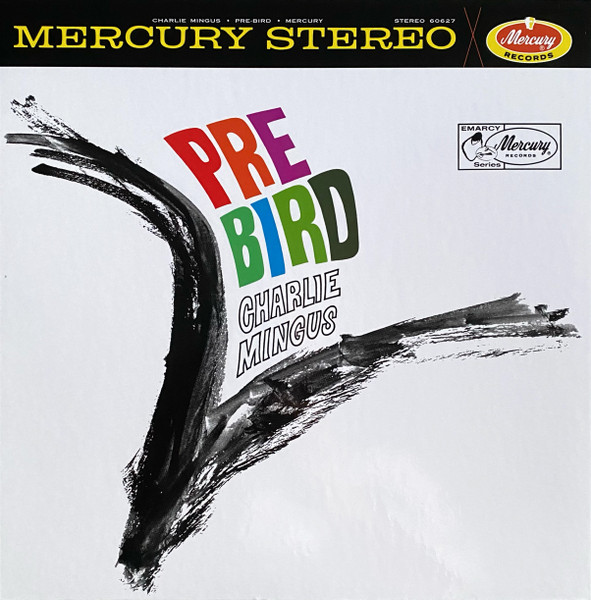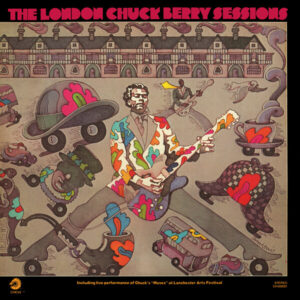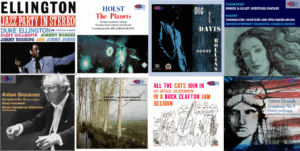The Thelonious Monk Quartet, Monk's Dream. Mobile Fidelity Sound Lab UD1S 2-011, Columbia 19075930421, Limited Edition, SuperVinyl, Box Set (2019, Sept.), # P001 of 6000. Originally released on Columbia – CS 8765 (1963, March).
Ratings
- Global Appreciation: 9.9
- Music: A+ (10)
- Recording: 9.6
- Remastering + Lacquer Cutting: 10
- Pressing: 9.8
- Packaging: Deluxe
Category: jazz, mostly cool with minor bop touches. Format: Vinyl (2x180 gram LPs at 45 rpm).
Musicians
- Thelonious Monk – piano
- Charlie Rouse – tenor sax
- John Ore – bass
- Frankie Dunlop – drums
Additional credits
- Produced by Teo Macero.
- Recorded October 31, November 1, 2 and 6, 1962 at Columbia 30th Street Studio, NYC.
- Engineered by Frank Laico.
- Remastered and lacquer cut by Krieg Wunderlich and Shawn R. Britton at Mobile Fidelity Sound Lab in Sebastopol, CA.
- Plated and Pressed by RTI, CA, USA.
- Photography Don Hunstein.
Just as the needle dropped, so did our jaws; and within the first seconds, we knew we were witnessing something special, read magical...man, was that all a dream?
Along with Dizzy Gillespie, Charlie Parker, Charlie Christian, and Kenny Clarke—re-inventing jazz in the early-1940s through a new musical language—pianist and composer Thelonious Sphere Monk stands out as one of the leading pillars of what would become known as bebop.
Monday Celebrity Nights at Minton's in Harlem was the place where all the cool cats would hang out, counting on cutting contests to pierce through the fray, fog, and noise of the late hours. Bearing exotic hats, shades, and goatee, no other musician better epitomized the beatnik look—with Dizzy doubling down by his side. Not only was he famous fashion wise, his mumbling, dancing, and prancing at and around the piano provided a great sideshow for all to see. But even blindfolded there is no mistaking such a unique colossal jazz figure.
Just as The Duke and Count proved royally important, both remained stylistically very distinct from each other for five decades or so. Like a metronome, you could count on Basie's blues invigorating the Kansas City swing style, sometimes through the use of block chords, and stomping rhythms. Whereas Ellington elegantly transitioned back and forth between consonance and dissonance, exploring emotions and tensions via major and minor intervals and scales like a lithe ballet dancer, while skillfully mastering the resolve response returning to the consonant world. In contrast, Monk mainly mired in minor intervals, or threw tone clusters throughout entire pieces; "Introspection," "Off Minor," and "Bright Mississippi"—the latter featured here opening side B—being perfect examples. Angular, oblique, dissonant, more staccato than legato; his hammering of the ivories never left one indifferent. To the untrained or unaccustomed listener, one might be forgiven for believing the record was cut or pressed off-center. If Duke dug Debussy and Ravel, Monk mingled with Schoenberg, Berg, and Bartók. But make no mistake, Monk's many celebrated compositions are not cerebral head music, this is toe-tapping music coming from the heart, going hand in hand with open minds and open ears.
During a four decade span, and similar to Miles' music path, Monk moved from label to label, starting at Blue Note with Genius of Modern Music [BLP 5002] recorded in 1947-48, and released in 1952 on 10-inch, which included many of his most covered, and signature songs including "Round Midnight"—sometimes titled "Round About Midnight"—"Off Minor," and "Rudy My Dear" just to name a few.
Followed by the "big three" of that era: Prestige, Riverside, and Columbia, with a few others of smaller footprint scattered in between and afterwards—only Verve didn't make the cut. Releasing fourteen albums for the label in five years, Monk's Dream marked his Columbia debut. As such, he shared some of the same production personnel and technical facilities as Davis and Dave Brubeck on their landmark albums–respectively 'Round About Midnight, Porgy and Bess, Someday My Prince Will Come, Miles Smiles, Filles de Kilimanjaro, and Time Out–where on this one, Fred Plaut was the engineer.
Producer extraordinaire Teo Macero and Columbia's 30th Street Studio in Manhattan, New York City are the main ingredients in the winning recipe linking these albums with engineer Frank Laico as the kitchen chef—all part of Columbia's coveted A-list. Recognized as one of the finest recording studios in the world, it was first constructed as a Presbyterian church back in 1875. Its architecture sported 100 foot ceilings and 100 feet by 100 feet of floor space—a perfect cube and normally a sonic disaster as far as spectral distribution and evenly spreading standing waves—most of the first reflections were naturally staggered farther apart in time than in a small room. Lights and drapes dangled down from the ceiling. Regrettably it was demolished in the mid 1980s for prime renting real estate—a repulsive recurring trend it would seem. Though not as big as Davis, Brubeck, nor Ellington as far as record sales go, landing Monk on a major was still quite a coup for Columbia and his own perceived standing, not forgetting financially as well. Soon after signing he received a first check for just over $8600 providing him the means to buy a $3000 Baldwin M Grand piano as a Christmas gift.
Entering 30th Street Studio, they let him choose among a few Steinway Grands. Glenn Gould, also with Columbia at the time, and notorious for being excessively demanding regarding pianos and their tuning—his favorite and famous of which being a Steinway no. CD 318, and chief concert tuner Verne Edquist respectively—would also have his pick. Coincidentally both men shared one thing in common that frustrated recording engineers: their mumbling at the keyboard. And like Macero, Gould would embrace and encourage the "art of splicing" to embellish a performance to perfection.
But back to Monk. Macero had a secret weapon to keep him happy and productive: ham sandwiches supposedly between takes. Joining him for the sessions were Charlie Rouse on tenor sax, John Ore on bass, and Frankie Dunlop on drums. Recording started October 31, 1962 continuing November 1, 2, and 6. Often arriving late, Monk kept to himself, having a habit of never talking to his musicians or the engineers, nor taking off his hat. Laico's recording method was pretty straightforward, spectacularly efficient, and musically magnificent. Like the Three Bears, his miking technique was not too close, nor too far away, but just the right distance from the instrument, about a foot or so away in many cases. He kept the musicians close together and angled towards the center, so as they could easily see and hear each other, with some strategic short and tall baffles between and behind them instead of headphones—which he immensely disliked, and became more widespread by the end of the decade.
Seven mics were used: one for each instrument except four for the drums—kick, snare, left, and right overheads—4 to 5 inches in front of the kick, the latter comprising a sandbag for reducing resonances running down the wooden floor. The control room's front wall situated quite close to it, served as sound reinforcement for the drummer and bassist—a passive acoustic monitor so to speak. To best capture the integrity of the double bass, Laico positioned the mic—likely an old RCA 44 ribbon—in front of one of the "f-holes" some 8 to 10 inch away, adding just a bit of EQ to it. On sax he liked the Neumann 67 half way up rather than directly in the bell to get a fuller sound plus a tall baffle in back but not too tight. Finally for the piano, he preferred having the lid open all the way, placing the microphone—a Neumann 49—about three-quarters of the way up, a few feet from the keyboard, to get an open sound in contrast to the "tight" sound often heard in that era. CBS/Columbia's custom console counted 16 input/rotary controls, and 3 track/meters as 3 and 2 track tape machines were still the typical tape format in the early-1960s. Note that he only recorded the sessions, somebody, somewhere else, also uncredited, mixed the seven inputs to stereo, and mono as well. We can presume that Macero being a very "hands on" producer participated in the latter steps. In an interview, Laico had this to say regarding the room's reverberation:
"The room itself had its own echo, which was very nice, but would be a different sounding echo with every session that came in. With the chamber, we could regulate the echo by adjusting the volume of each instrument. Every mic had its own send, so we could set its level, and we could also regulate the return. Still, the sound of that return didn’t sustain itself. Then Les Paul told me about how—at his home studio in New Jersey—he smoothed things out nicely by running the sound from the echo chamber through a tape machine. When I tried that, it worked, warming things up and increasing the length of the decay, and afterward everybody in the business–including some engineers from England—showed up, wanting to know how we got that echo chamber sound."
This is the ninth UltraDisc One-Step 45rpm box set released by Mobile Fidelity, and the fifth one in my collection after buying Santana's Abraxas [UD1S 2-001] followed by Bill Evans' Sunday at the Village Vanguard [UD1S 2-002]—I skipped Donald Fagen's The Nightfly [UD1S 2-003] and Simon and Garfunkel's Bridge... [UD1S 2-004], finding those selections less interesting to my musical tastes, and somewhat odd for this premium format given so many incredible ground sound breaking albums instead. Rejoiced with Marvin Gaye's What's Going On [UD1S 2-008]. Skipped SRV's Texas Trouble [UD1S 2-005] because blues rock recorded in the early-1980s is not my Texas tea. Bought Bill Evans' Portrait in Jazz [UD1S 2-009], and skipped Bob Dylan's Blood on the Tracks [UD1S 2-006] for not being a big Dylan fan. After Santana's stunning success selling out its 2500 copy run within its first month, the succeeding special editions kept gaining in limited numbers to reach 7500 at one point—a three-fold increase, and once more they sold out in pre-order status! This one is back down to 6000 and was backordered for a while. As in all cases, the two LPs are housed, and presented in a deluxe one-inch thick, quasi black / very dark grey, subtly soft-textured carton box with gold-colored lettering and trimmings, framing the original cover art–by photogapher Don Hunstein—in a reduced 8 1/2 x 8 1/2 inch slightly sunken square.
Upon opening, a dark grey foam hides the precious jewels; under which, a 12 x 9 inch horizontal and 8 x 12 vertical B&W archive photos of Monk playing piano by Hunstein.
Next in line is a thin cardboard with pictograms explaining in great detail the unique "one-step" process. This is followed by a full-size cardboard printed replica of the original front and back cover art, with MoFi's ubiquitous strip added at the top but minus the original's STEREO "360 Sound" rectangular-arrows logo, and Columbia's square "eye" logo, both in the top left corner. While the back omits the STEREO "360 Sound" explanation at the top. The original front background tint seemed turquoise-greener—at least on my computer screen—than MoFi's less saturated bluish-grey tint.
Finally we reach the treasured vinyl, inserted in individual numbered cardboard sleeves similar to the box cover art, with the track titles printed on the back side. These are now improved, and better match the outer box in shade and texture. Whereas the former one-step releases were housed in black hard covers that were prone to scuffs or visual blemishes, the new softer ones look more distinguished, and were visually perfect, which should please many that found the old ones not commensurate with the premium price. The LPs are further protected, by MoFi's inner HDPE sleeves inside a white folded cardboard. As usual with MoFi, no attempts were made to duplicate the original Columbia "360" label, replaced instead with the same design as their other UD1S LPs.
Lastly a second foam, "cushions the blow" from box handling. Granted, these boxes make it a bit more cumbersome to store and listen to an LP, but I like them for their classy, distinguished look and feel, reinforcing the "collectible special status."
All four sides of the MoFi were stunningly shiny, with no scratches, or scuff marks. Upon my first listening session, I did encounter some very minor noise floor artifacts at the end of sides A and B, the last seconds of the music just before the dead wax begins, but seemed to disappear the second time, leading me to believe it was mostly caused by static from sliding in and out of the HDPE sleeves. The second record was noise and static-free. Interestingly the exact same thing happened with the Marvin Gaye UD1S. The new vinyl compound—called SuperVinyl, was developed by NEOTECH and RTI purported to reduce the noise floor, and enhance the groove definition—ironically RTI's regular opaque formula, which MoFi uses on the rest of their catalog, seems to have a "blacker" background, but more on that subject further below. Though carbonless, it retains a traditional black dye as opposed to Classic Records' Clarity formula, which ditched the black-dye along with the carbon, making MoFi's formula easier to cue, more classic looking, and visually warmer than clear vinyl. Even so, with the MoFi you will still see the glow of a light bulb passed through if held in front of it—similar to the first thinner JVC MoFi pressings. I roughly measured 1.5 inches, 1 inch, 1.75 inches, and 1 inch respectively of runount groove, aka dead wax, all sides staying far from the label area, so there should be no high frequency audible deterioration due to the pinch effect and smaller groove radius at this safe distance.
In a nutshell, whereas a normal "three-step" release utilizes the following chain: [lacquer + father + mother + stamper], the "one-step" method skips the father and mother intermediary steps, going from lacquer directly to stamper or "convert" in this case. Because of the limited number of pressings that the delicate convert can withstand in the typical press before audible deterioration creeps in—supposedly somewhere around 500 or so for 180g LPs—it implies that a minimum set of 12 converts per side must be created from a set of 12 lacquers per side to meet the expected target of 6000 copies. This not only takes the remastering / cutting job twelve times longer to perform—unless they are able to hook up in parallel more than one cutting lathe—but also exposes the precious original master tape to more wear and tear—the iron oxide, binder (glue), and acetate, mylar or polyester carrier coming apart sometimes with time, aka "binder breakdown," and remedied only by "baking" the tapes for precise times and temperatures. Not to mention how boring it must become for the cutting engineer, doing over and over the same music master disc. Considering all of the above, the $125 asking price still seems well justified if the superb quality maintains its previous level.
It also suggest that there could very well be minor differences in sound among the 12 "plate" sets, and as such, differences in sound between box sets, relative to the "batch" number that the consumer happens to get—more so than the usual MoFi release or any other label following the normal three-step process, all else being equal (which admittedly is rarely the case, especially regarding vinyl because of the multitude of variables from master tape before reaching your platter, and everything subsequent to that). One can also ponder if, for example, the 12th cutting run is either "penalized" because of the tape wear, or rather privileged for getting the EQ and groove-spacing "spot-on;" then again are all the parameters/choices "locked-in" for the total "project run" to maximize uniformity? What about the cutting stylus—does it get changed for every set?
Following that logic, there are perhaps up to 12 sets of A, B, C, and D. Now one would presume that the first batch (#1 to 500) would be etched "A1; B1; C1; D1" and the last batch (#5500 to 6000) would be "A12; B12; C12; D12." That is not the case for my #P001 copy bore the respective matrix / runout stamper etchings: "UD1S2-011 A3; B2; C2; D3 KW@MoFi."
The KW initials in the dead wax etchings as usual stands for engineer Krieg Wunderlich, who in this instance was assisted by Shawn R. Britton. For my previous MoFi one-step reviews of the Santana, Bill Evans' SATVV, and Marvin Gaye releases, please go HERE, HERE, and HERE.
Now pour yourself a brandy, close your eyes, and let the dream begin...
Similar to Santana, the first thing that I experienced in the lead-in groove just before the first note hits, was what I presume is very low level room rumble as one encounters when entering a vast concert area, hinting at Columbia 30th Street's huge volume of recording space, as if a big subwoofer suddenly appeared barely purring, pouring the foundation of what is to come. Then it happens. Monk starts the ball rolling on the 4 before the one on the title track—a cool swinging mid-tempo number—as Dunlop and Ore join in on the one, the three take it for a short spin with Rouse coming on board a few measures later. Let me cut to the chase.
The sound is to die for. Santana was spectacular, and Bill Evans' SATVV was also quite impressive, while Marvin Gaye was the most refined, and perhaps sonically the best of the UD1S boxes...that is up until now. Monk's Dream is at least its equal, or even surpasses them all! Starting with Monk, the sound of his Steinway is the most convincing I have heard on record—it's a Grand alright, and that is the conveyed impression. Forget about Blue Note, we couldn't be further than Van Gelder's typical tiny boxed-in piano sound of the same era. For a fairer and closer comparison, it surpasses Bill Evans' and Monk's own Riverside recordings, which are still excellent, but do not achieve the level of realism attained here. Even my previous piano references—the Three Blind Mice Japanese trios from the mid-1970s, or Analogue Productions' 45rpm of Basie' 88 Street (HERE) fantastic as they are, now face fierce competition. In fact the only record bestowing a piano with such realism that readily comes to mind is the For Duke D2D from M&K (HERE).
What impresses so much on this MoFi UD1S, is the sheer strength or force of the hammers striking the strings. It is cleaner, less distorted, more resolute, more stable, better defined, and articulated than anything I've ever heard, save for a true live close up performance. Of equal importance is its even tonal balance, acoustic power, presence, and physical scale. When the quartet is playing, Monk is situated front center right, but on a few tracks playing solo—such as "Body and Soul," and "Just a Gigolo"—the Grand takes full advantage of the complete left to right stage, simulating Star Trek's holodeck—minus the weak story line of course. The Steinway's sustain is solid as rock. On these two pieces, the dissonance dominates with no place to hide behind, to the extent that the piano, player, tape or turntable for that matter appear drunk or drifting at sea.
The drums in the left channel are very well balanced between the four mics allotted to it, and sound utterly natural with just the proper ratio of precision and room ambiance. The cymbals are some of the best sounding, showing correct shimmer and sweetness, with sufficient detail to differentiate the hi-hat foot pattern in tandem with the ride rhythm doubling over it. The acoustic bass placed center stage is generally well captured, especially in the lower tones providing pleasant bottom bounce, but lacks a bit of articulation or pitch definition to follow every note—in other words, though it is more generous or plump than your typical RVG Blue Note LP, do not expect the finger-snapping string detail of a Three Blind Mice nor Scott LaFaro's work on SATVV mentioned previously, where your ear seems six inches from the instrument. Not surprisingly it resembles the type of bass presence that we find on other Laico engineered Columbia sessions of the period such as many Miles Davis recordings done at the same location. It is mainly for that reason that I don't give it a perfect score regarding the recording rating.
Finally the sax also occupies the center stage just barely receded from the midplane. Rouse has a solid presence, but at no point does he ever steal the spotlight from his surrounding cool cats. There is no "Coltrane" moment, nor a Colossus Rollins or hawkish Hawkins' bark blowing overboard, and taking full charge! That said, the quartet swings hard and tight while Monk, like Miles, leaves them sufficient space to groove. From a more general perspective, the tonal balance is slightly warm, and perfect at different listening levels. It is one thing to get the lows, mids, and highs broadly in proper proportion, but this is the rare case where I find that the ten audio octaves are exactly spot on—and even if I am extremely difficult on the latter, I would not alter one-tenth of a dB! The dynamic window appears quite natural also. Each instrument is so well defined, clean, and solid as if the intermodulation distortion between them vanished. The resultant is a fatigue-free, exciting performance, and reproduction—a touch more Master Tape sweet than direct-to-disc front and lean.
All four sides were equal in musicality and sound quality. In that context, I feel it is in the same league as my two prior Monk favorites: Brilliant Corners and Monk's Music (HERE) regarding musical significance. As for the subject of the SuperVinyl formula: starting with the Marvin Gaye release I had noticed that it brought a minor improvement mostly in the areas of transparency, leading edge, micro-dynamics in the midrange, and ever so subtle sweetness, and lesser grain to the whole treble. I would add that it seems to make the reproduction medium self-erase, and increase the auditory illusion, making the trade-off regarding the small static issue, well worth it. I did not have an original US pressing to compare with but the leap in sound quality is so big that a regular 33 1/3 rpm original cannot compete, period. Finally, if you missed your shot with the Bill Evans' Portrait in Jazz [UD1S 2-009] which is sold out since a while, get this Monk instead. In my opinion it is more impressive both musically, and sonically by a significant margin.
To conclude, Mobile Fidelity's ninth UD1S—Monk Dreams—is the audiophile's ultimate dream come true. 'Master cutter' Krieg Wunderlich assisted by Shawn R. Britton outdid themselves once more. Some may think "there he goes again" but let's give praise where praise is due. With these monumental UD1S releases, MoFi is a towering tour de force advancing the state of the art.
And now unfortunately I must wake up.
For more from Claude Lemaire go to his blog...
http://soundevaluations.blogspot.ca/




